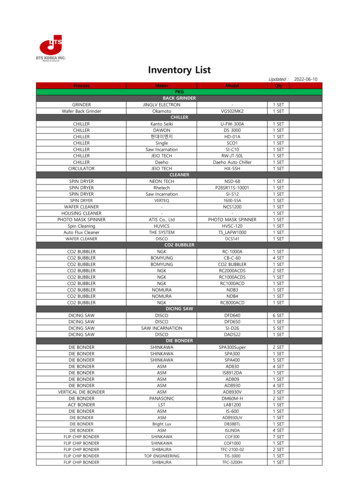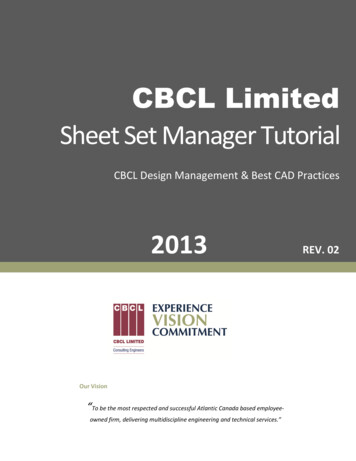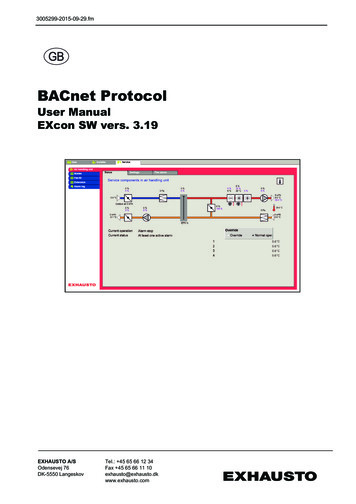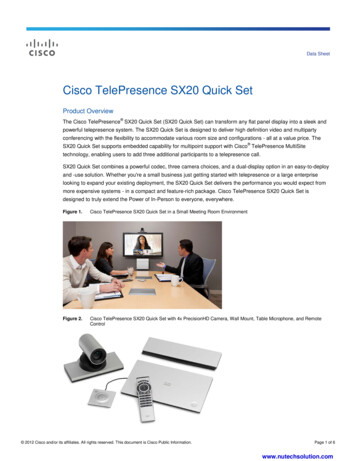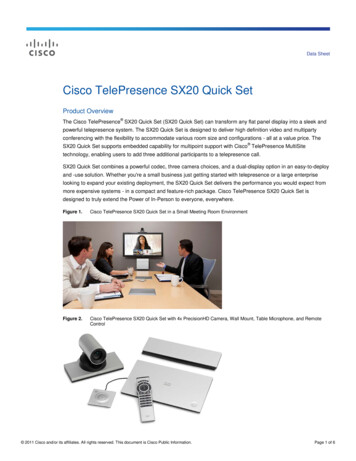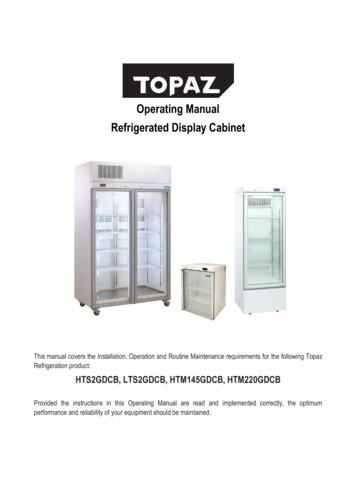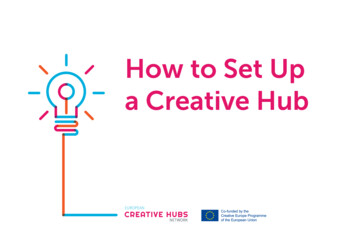
Transcription
How to Set Upa Creative Hub
ContentsIntroduction01Learning Outcomes 031. The Creative Hubs Ecosystem042. Starting a Creative Hub 103. What makes a successful Creative Hub?174. Growing your Creative Hub26Reflective Learning 34The European Commission support for the production of this publication does not constitute an endorsementof the contents which reflects the views only of the authors, and the Commission cannot be held responsible forany use which may be made of the information contained therein.The statements, reflections and opinions contained in this publication are solely those of the individual authorsof texts and visual contributions, and do not necessarily reflect those of the editors or the publisher.
Introduction“Now is the moment andopportunity for Arts toprove a case - the valuebeyond art itself”About the programmeThe European Creative Hubs Network (ECHN) is a two-year project co-fundedby the European Union through the Creative Europe programme. The projecthelps Creative Hubs connect and collaborate across Europe.Launched in February 2016, ECHN is building a community network of CreativeGerfried Stocker, Artistic Director- Ars ElectronicaHubs by hosting a series of people-to-people encounters incorporating training,debates, best-practice sharing, and other topical and sometimes difficultdiscussions. The project is led by the British Council, in partnership with sixCreative Hubs across Europe: Bios (Greece), Betahaus (Germany), CreativeEdinburgh (UK), Factoria Cultural (Spain), Kulturni Kod/Nova Iskra (Serbia), Roco(UK), and the European Business and Innovation Centres Network (EBN).1How to Set Up a Creative Hub
About the 3 trainingworkshopsThe project aims to build the capacity of Creative Hub leadersand therefore contributes to the resilience of Creative Hubsacross Europe.One strand of its activities focuses on skills development forCreative Hub leaders through workshops. In 2017, a series of threeworkshops have been designed and hosted by project partnersFactoria Cultural, betahaus Berlin, and Creative Edinburgh - withsupport from the British Council. Each workshop targeteda slightly different audience, from leaders who are at thebeginning of their Creative Hub managing career to those whohave extensive experience and are ready to set the next trend inthe Creative Hub world. The Skills Diary for Creative Hub Leaders developed by the British Council together with SNOOK - collectslearning outcomes from the three workshops, and provides openaccess for the whole Creative Hubs network.About this toolkitThis toolkit builds on the European Creative Hubs SkillsWorkshop organised in Madrid on 22nd - 23rd March 2017.Factoria Cultural hosted the workshop - the first in a series ofthree, aimed at developing the skills of Creative Hub leaders atthe beginning of their careers - which touched on elements offinancial sustainability, building a community, and setting up aneducation platform. In each section, a list of additional resourcesinvites you to explore further before moving on. Links are forinformation only and do not constitute an endorsement.2How to Set Up a Creative Hub
LearningOutcomesBy the end of this toolkit, you will be able to: Understand the Creative Hubs ecosystem. Learn how to start and grow a Creative Hub. Understand basic elements for the day-to-day running of aCreative Hub.3How to Set Up a Creative Hub
1. TheCreativeHubsEcosystem1.1 Building connectionsbetween creatives andthe economyCultural and Creative Industries (CCIs) play a leading role innational economic growth policies because of their dynamicnature, their structural contribution to production andemployment, and their potential for growth. In Europe, CCIsprovide more than 12 million full-time jobs which amounts to7.5% of the EU’s work-force, creating approximately 509 billion invalue added to Gross Domestic Product (GDP).Source: A coherent EU policy for cultural and creative industries.How do we build the link between the creative sector and theThe ecosystem of Creative Hubs across Europe is now wellestablished. It offers the opportunity for new Hubs to buildupon their learnings and successes.4How to Set Up a Creative Hubwider economy? How do we nurture the areas where creativity isgrowing? This is where Creative Hubs play a vital role: they allowcreatives to connect, communicate and collaborate.
This is particularly crucial for newer creative areas. Creative Hubsenable creative professionals to communicate across sectors, tolook globally, to keep evaluating and refining their offer, to learn,get feedback and gather the evidence they need to grow. CreativeHubs also act as a conduit between the creative, cultural and techsectors, as well as stakeholders, policy-makers and government.“A Creative Hub is a place, eitherphysical or virtual, which bringscreative people together. It is aconvenor, providing space andsupport for networking, businessdevelopment and communityengagement within the creative,cultural and tech sectors.”Creative Hub definition,Creative HubKit, p.45How to Set Up a Creative Hub
1.2 The growth ofCreative HubsCreative Hubs are fast becoming a worldwide phenomenon. Inthe last ten years, hundreds of innovative spaces where peoplecan design, test, scale and launch enterprising new ideas havepopped up around the world. The United Kingdom has had asizeable role in propelling the development of Creative Hubs,and most cities in the UK host a thriving number of Hubs. Thegrowth of the European Creative Hubs Network testifies to theirsuccess and increasing impact. Creative Hubs help organise the“Artistic creativity and criticalthinking are essential for innovationin today’s digital world. Already,highly innovative companies likeMercedes thrive on a strong linkbetween artists and their engineers”Commissioner Günther Öttinger(in answer during EP hearing)creative economy, enable innovation and development, and haveallowed the sector to capitalise on technological advancementswhich facilitate greater audience reach and help transform peoplefrom consumers to creators.Read More:A Coherent EU policy for cultural and creative industriesAcross Europe, urban regeneration projects regularly engagehttp://bit.ly/eupolicyculturalcreativeswith the creative industries to overcome the decline of traditionalCreative Hubs: Understanding the New Economy Reportindustries, complement the education system (in particularhttp://bit.ly/CreativeHubsReportaround innovation), engage with young people and tackle youthThe European Creative Hubs Network w to Set Up a Creative Hub
1.3 The impact ofCreative HubsActivity: Understandingyour business environmentCreative Hubs are shaped by the needs and capacity of localUnderstanding the ecosystem around Creative Hubs acrosscreative industries and the economy. They are embedded inEurope is an invitation to broaden the horizon, analyse theparticular cultural contexts, supporting specialised creativeenvironment around your Hub and use the experience, on thepractices and developing their own value systems.next page, of other hubs to maximise the impact. Use the activitybelow as a reflection to explore the needs, risks, opportunities andSuccessful Hubs have two common traits: resilience andthe unique selling point of your Hub.sustainability. These Hubs understand the businesses andcreatives who work within their environment, and are able torespond to their needs. The British Council report Creative Hubs:Understanding The New Economy, outlines the wide-rangingimpact of Creative Hubs - from fostering start-ups, jobs, productsand services, to helping secure investment. Creative Hubsdevelop and retain talent, create engagement and educationalopportunities. They encourage regeneration, research anddevelopment, and foster networks at municipal, regional andinternational levels. Their innovative organisational models lead togreater flexibility and a better quality of life.7How to Set Up a Creative Hub
What local or internationalWhat might be the risksHow might you turn themWhat might be uniqueneeds might the Hub meet?involved?into opportunities?about your alEducationalPolitical8How to Set Up a Creative HubActivity: Understanding your business environment
1.4 Planning evaluationfrom the startCreative Hubs often struggle to evaluate their impact andarticulate their value proposition, particularly when speaking topotential investors.Evaluation doesn’t have to be a time-consuming task, especially ifit is embedded in practice from the start: With no universal evaluation tool, Hubs can find it difficult todemonstrate their value to potential funders and local authorities.ECHN is developing a pilot barometer tool which will establish abaseline across Europe. The barometer will enable Hub managersto promote their Hubs and better understand where they fit inthe creative economy. Self-assessment from Hub managers willinform trends in their sector.Read More:Creative Hubs meter-pr/Values: What are the core values that your Creative Hubidentifies with? What will be the impact? Beneficiaries: Who are the key beneficiaries of your network?Your Hub will support their growth. In return, how will theirsuccess demonstrate the value of the Hub? How will youshare their stories with prospective beneficiaries and funders? Evidence: To demonstrate impact, you will need a baseline.How will you measure impact? Do you have access to externalresearch? Will you collect data through feedback forms? Willyou conduct in-depth interviews with your beneficiaries tounderstand their experiences, needs and challenges?9How to Set Up a Creative Hub
2. Startinga CreativeHubIf you are thinking of creating a Hub, this chapter will stimulateyour thinking. If you are already on your way, you can review“Many cultural and creativeorganisations react negatively tothe world of business, yet theyneed sufficient financial resourcesto carry out the present and futureactivities they have planned. Theadvantage that the concept of abusiness model brings is that itfocuses on creating, deliveringand capturing value”areas that were overlooked during the early days.Factoria Cultural’s Innovation Plan10How to Set Up a Creative Hub
2.1 Before you startSuccessful businesses prosper because they respond innovativelyto an opportunity, a need or an anomaly in which they seebusiness potential. Starting a business isn’t for the faint-hearted.It requires hard work and persistence, so be prepared to do yourresearch. Research. Research. Research. This will help you scope outdemand in your area, understand the needs of potentialbeneficiaries, and analyse the market. Network with otherHubs to learn from their experiences or go on an internationalpeer-to-peer exchange. Assess your motivation. What interests you in creating a Hub?Are you looking to be in control of your creative practice?Support the success of other creatives? Assess your own capability. Do you have the right skillset?Are you technical, great at organisation, or have you welldeveloped communication skills? What are your assets? Doyou have the time you will need to see this through? Read More:Nesta’s Creative Enterprise Toolkithttp://bit.ly/CreativeEnterpriseToolkitHow Work Workshttp://bit.ly/howworkworksArts Council England - Starting a businesshttp://bit.ly/ArtsCouncilEnglandResearch legal and practical issues. What do current laws andregulations say regarding design rights, insurance, health andsafety, or copyright?11How to Set Up a Creative Hub
2.2 Generating an incomefor your HubYour business model depends on the beneficiaries identified inAnother example is Nova Iskra in Belgrade, Serbia. It is a grassrootsand multi-functional creative workspace with a hybrid businessmodel (see next page): services dedicated to individuals and team members, andyour business plan. You need to understand their requirements,motivations and issues so that you can design an offer that meetstheir needs and is sustainable.For example, this is how IMPACT HUB in Madrid, Spain co-createdthe growth model for their global network 80 hubs. meetings. Entrepreneurial support: Business skills training, incubationand acceleration programs, networking opportunities. Collaborative community: Hosting a diverse community ofentrepreneurs, practitioners, investors and organisations. event services. professionals, entrepreneurs and companies. Communications across all channels, visual design and agilecontent contribute to the overall image of the Hub, which isimportant for the business. Industry relationships: Nurturing relationships with selectedcompanies. Client service: Design services delivered to a range of clientsfrom startups to multinationals. Advocacy and media presence: Nurturing relationships withgovernmental and NGO stakeholders, chambers of commerceImpact ecosystem: Connecting key actors across sectors tocollaborate on common challenges.Education platform: Training, courses, open lectures,mentorship and other diverse programs aimed at creativeWorking infrastructure: Inspiring collaborative working space,essential business services, an attractive spot for events andSupreme coworking service: An award-winning space,and other institutions. International collaboration, national and regional leadership. Internal growth: Constant reflection on growth and teamculture.Factoria Cultural Madrid provides another evelopment/12How to Set Up a Creative Hub
The complex diagram (left) showcases the Nova Iskra model at the very beginning of their journey whereas the simple diagram (right)represents where they are a few years down the line.13Reproduced with permission from Nova IskraHow to Set Up a Creative Hub
2.3 Finding the rightbusiness modelExploring how Creative Hubs across Europe have developed avariety of hybrid business models will help you define the rightone for your Hub. Whether for-profit or not-for-profit, the legalframeworks vary according to context. It is important that youmake an informed decision when setting up your Hub to ensureits legal status is adequate for your activities. Most cities runbusiness services and might even be able to assign you a personaladviser. You can also consider courses, online or locally.Writing your business planA business plan outlines your vision and how you intend toachieve it. It should be a living document, evolving as yourbusiness grows: Business objectives: what is your vision? The type of Hub you intend to run: for example, are youart-focused or open to a wide range of creative initiatives? The demand: who are the customers and competitors? Whatis your Unique Selling Point (USP)? Marketing: how do you intend to market your Hub? Finances: what are your estimated earnings, overheads, cashflow and funding sources? Organisation: how will the Hub be structured legally andpractically (premises, staff, equipment)? Evaluation: how will you measure the success of the Hub?Read more:The Guardian, Business plans:tips for arts, culture and the creative A Business Model model-canvasCultural Enterprise Office:14How to Set Up a Creative ervices/resources/
Activity: Understandingyour customersTime to put your business hat on! This activity is designed to helpyou understand better the people, organisations and businesses whowill be benefitting from your Hub. In this context, we will call themyour customers. Successful Hubs are the ones who understand theircustomers’ motivations and pain points. Use the questions in thisactivity as an interview guide. Feel free to refine it to suit your Hub.Once you have interviewed your customers, read your notes and askyourself: what are the recurring themes?15How to Set Up a Creative Hub
What are your organisation’s objectives?What would discourage you?(Understand what they do, why they do it, where they see themselves in the future)(Understand what would put them off from working with the hub)Where do you work and where would you like to work?Your questions.(Understand where they live, how they travel, any constraints such as disability,income, childcare.)What would you need from a Creative Hub?How can we stay in touch?16How to Set Up a Creative HubActivity: Understanding your customers
3. Whatmakes asuccessfulCreativeHub?This chapter will walk you through 3 ingredients of asuccessful Hub: a top team and an attractive space3.1 Fostering talent withinyour teamCreative Hub leaders wear many hats, but one of the mostimportant roles is to support their team. As a successful hubleader, you should be able to: Lead by example: be open about your desire to developwithin your role and share the steps you take. Open dialoguehelps to reduce misunderstandings and solve situations faster. Reinforce continual learning: speak about your team’s goalsand find the motivations behind each goal. You can do itat the end of projects to celebrate the outcome and thelearning. It is important to acknowledge difficulties and discussimprovements. Foster sustainable development: Hub leaders should beable to coach their team. Team members should have a clearunderstanding of how their talents fit in with the organisationand where they need to grow. Reinforce Hub values: your team needs to see how theireveryday responsibilities contribute to the overall developmentto build a vibrant community.of the Hub, and why what they do is important. See challenges as opportunities to learn: allow your team topursue challenges that might not work out. Teams learn newskills through failure, without risking their careers.17How to Set Up a Creative Hub
“Creativity as a processunderlines the way in whichwe work, our approaches andthe ways in which we thinkand act:- how we deal withthe challenges of setting upsustainable business models,dynamic work environments,or rich and diversecommunities and audienceswe are serving and supporting.”Relja Bobić - An Inventory of effects - How WorkWorks - http://bit.ly/howworkworks page 518How to Set Up a Creative HubTo learn more about how to be a better Creative Hub Leader,please see How to be a Creative Hub Superhero toolkit.
3.2 Designing your HubDesignCreative Hubs are designed to meet the needs of their users.A major appeal of Creative Hubs is their wide range of availableThey are also influenced by the interests of their teams and thespaces, from small-scale ‘hot-desking’ for solo entrepreneurs, toneed to differentiate themselves from other Hubs. To becomelarger areas where bigger companies can customise the spacea sustainable and influential community player, getting theto suit their style and needs. Event spaces, meeting rooms,location and design right is key.collaboration spaces, and cafes and shops enhance work life.The aesthetic design of the Hub is important, both as a firstLocationLow rent is a key factor in choosing a location, and while Hubsare commonly found in urban areas, it is worth remembering thatmonthly costs for work spaces can be higher within city centres. Aimpression and as a daily experience. Many Hubs allow theirlong-term tenants to customise their spaces, making themvisually interesting and aligning them with their own values. Forexample, exploring how design (furniture, light fixtures, etc.) canbe ecological if the Hub aims to have low environmental impact.Hub may wish to be close to a specific community or within areaswhich lack a certain industry.There are a few different space ownership models to consider: Private ownership – in leased or owned space. Public-private partnership – cooperation with localcommunity or city level authorities. Public ownership – initiated and financed by public sector ondifferent levels.19How to Set Up a Creative Hub
3.3 Building yourcommunityA Hub in a great location with an enticing design attracts newusers. However, the strength of the community is what makestenants stay.Consider employing aCommunity ManagerCommunity Managers maintain and grow a healthy community.They make sure that tenants, stakeholders and staff are informedand involved in decisions, events and new ventures. Theyalso provide vital professional links between Hub members,encouraging collaboration which strengthens not only the HubGreat co-working comes from thecommunityHub events connect people and encourage networking. Letthese form organically, identifying the needs and work patterns ofyour tenants, and the frequency with which events should occur.Breakfasts, afterwork drinks and film nights will encourage socialitself but also its members.Barriers to creatingsuccessful communities wi-fi, convenient opening times, as well as a comfortableinteractions. Talks - either from within the Hub or from externalcontributors - and learning lunches will encourage professionaldevelopment.Logistical issues within the space, such as natural light, fasttemperature and noise levels. Cloud-based issues are of fundamental importance for onlineHub communities, and it is key to have a platform that works,shares information and promotes the community’s values. Itmust be maintained and updated frequently.20How to Set Up a Creative Hub
Engaging communities onlineWhile it is crucial to connect your community members throughevents and activities, let’s not forget that a large part of socialinteractions and communication happen digitally. For this reason,invest time to develop your hub’s social media channels and auser-friendly website. Whether it is a community manager or yourself, allocatetime each week and, preferably, each day to update, respondThis will help you to understand the interests of your hub’scommunity, but also give you new ideas for improving content.If you are promoting an event, encourage your hub members toshare it. Most of the content that you post will probably behub–related, but do not be afraid to address topics that aretrending in your city, larger hubs’ community, creative industriesor promote opportunities to participate in international events,such as the Creative Hubs Network workshops. If you are nota ‘digital native,’ do not worry. There are abundant resourcesavailable to brush up on your community engagement skills.and interact with your community and relevant audienceon Facebook, Twitter, Instagram or any other media outlet(choose those which are most relevant and widely usedamong your target communities). Use an easy to find name on social media platforms, preferablythe same as your hub’s name. Begin to share and post relevant content that interests yourtenants, stakeholders and staff. Include questions in your posts and images – something thatwould grab the attention of the reader.21How to Set Up a Creative Hub
Creative Dundee:Creative Dundee has managed to reach new levels of communityengagement via digital tools. Here are a few figures revealingtheir impact:4,844 Likes10,200 FollowersFacebookTwitter31,000 Plays315,350 ViewsVimeoFlickr1,077 Subscribers33 StoriesMailchimpStorifyThe key to a successful community is getting the balance rightbetween: The community and the individual. The mixture of disciplines within the Hub. The mixture of ages, genders, and backgrounds. Short and long-term members. Local and international members.Activity: Exploreyour communitiesYou can use the Stakeholder Map in various contexts to analysestakeholders i.e. people who come into contact with the Hub.2,507 FollowersAce!You can use it here to explore the communities in and aroundInstargramGoogle / Facebookthe Hub. Use sticky notes to brainstorm every community. ForAnalyticsUp to 5kper eventFacebookLive Streaming22How to Set Up a Creative Hubexample, local schools, art graduates, employment services, localcouncil, networking groups, contractors etc. Don’t worry aboutrelevance at the beginning. Then move those which have thegreatest potential toward the centre.
Activity: Explore your communitiesHow to Set Up a Creative Hub
3.4 Creating strongconnectionsYour new Hub exists within a local and national community, andamongst similar organisations across Europe. Building strongconnections with stakeholders and other Hub leaders will embedyour Hub in this supportive ecosystem.Local and national networksCreative Hubs are generally bottom-up initiatives that springfrom a local need, therefore staying connected with the localcommunity and local authorities contributes to the success ofyour Hub.A few simple steps you can take to start engaging with the localcommunity are: Up your social media game. Organise a Hub visit for the public - show them what you do. Host events (talks, workshops, etc.) open to the public - youcan even charge symbolic participation fees. Showcase stories from your community of creatives.24How to Set Up a Creative HubA great example on how to engage communities and connectwith stakeholders is Creative Dundee’s 99 Things to See and Do inDundee, an entirely crowd-sourced city guide new-99-things-tosee-and-do-in-dundee/By making your Creative Hub visible and more vocal, you will: Put your Hub on the map of the local community. Gain legitimacy and credibility in the creative economy sector. Benefit from other sources of funding. Have access to new partnerships.
International networkInternational connections can expand the horizons of your Hub.Working cross-border will improve your Hub’s visibility and helpbuild a strong track record of experience. It can open doors tonew partnership opportunities that can benefit both the growthof the Hub, as well as the development of its community ofresidents.To extend your Creative Hub’s international impact, you can: Join an international network for Creative Hubs:http://creativehubs.eu/add-a-hub/ Participate in international events, meet people, and ask fortheir advice (Don’t be shy!) Partner with similar Hubs to enable your residents to visit eachother. Connect with other Hubs online - organise live digital sessionsfor your communities. Ask other Hubs and partner organisations to introduce you tointernational contacts.Read More:Culture for cities and ties-regions/25How to Set Up a Creative Hub
4. GrowingyourCreativeHubPart of starting your Hub is to start thinking about how it mightlook and feel in a few years, how it might grow, how it might befunded and how you will manage when things get tough.4.1 Anticipate growthWhat will your growth journey look like? Pre-incubation to prepare the business idea and assess itsviability. Incubation to move from the idea to a viable business modeland see the company set up and enter the market. Acceleration to accelerate the company’s growth anddevelopment.This model is inspired by the Factoria Cultural’ InnovationProgramme by Prof. Dr. Francisco Gonzáles Bree & Prof. Dr. JoséAntonio Cano.Think about how your team will develop the competenciesthey need to lead, innovate continuously. Experts in your fieldand business mentors will also be key to your Hub’s growth.Networking with other entrepreneurs will help you to keep themomentum. How will the Hub grow without fragmentation ofpersonal relationships or losing its values? How will itamplify its offer?26How to Set Up a Creative Hub
“Top tips:Keep refining,Get feedback,Collect evidence”Judith Tolley Centre for Fashion Enterprise4.2 How will you fundthe Hub?Consider how the Hub will be funded at the start and as it grows: You, through savings or a loan. Family and friends. Grants and loans from government agencies or trusts. Manycities and regions invest in cultural and creative businessesas part of their urban development strategies, to improve thequality of life and provide an economic boost. A local businesssupport service will be able to help. and knowledge in exchange for a share of the equity of theRead More:How to be a Creative Hub Superhero n-toolkit/Angel investors provide capital as well as expertise, contactsbusiness. Venture capital for businesses with high growth potential.27How to Set Up a Creative Hub
CrowdfundingCrowdfunding is an effective method to fundraise for a specificproject but requires careful planning to reach your target. Pick the right project: one with a clear outcome and the righttiming. Set a realistic target: work out exactly how much money youneed to raise and tell backers how you will use their money.Factor in overhead costs, funding rewards and commissions. Prepare your pitch: include an explanatory video with a pitchthat is short and clear. Find the right platform: you may crowdsource using yourown methods or use a crowdfunding platform. Conditionsvary so it is worth comparing them. Prepare a thorough marketing plan. Use your networks: give your community time to spreadword-of-mouth. Invite your followers to pledge and share thecampaign through their own networks. Keep your backers engaged: thank them, update them on theprogress.Read More:Culture-specific information on funding4culture/Fundraising undraising-basics/fundraising-plan/How to prepare a marketing 2/arts-culture-marketing-planCrowdfunding ndiegogohttps://www.indiegogo.com/enGoFundMe28How to Set Up a Creative Hubhttps://uk.gofundme.com
The Creative EuropeProgrammeCreative Europe is the European Commission’s frameworkprogramme for support to the cultural and audiovisual sectorswith a budget of 1.46 billion to:
Starting a Creative Hub _10 3. What makes a successful Creative Hub? _17 4. Growing your Creative Hub _26 Reflective Learning _34. 1 How to Set Up a Creative Hub Introduction About the programme The European Creative Hubs Network (ECHN) is a two-year project co-funded by the European Union through the Creative Europe programme. .
